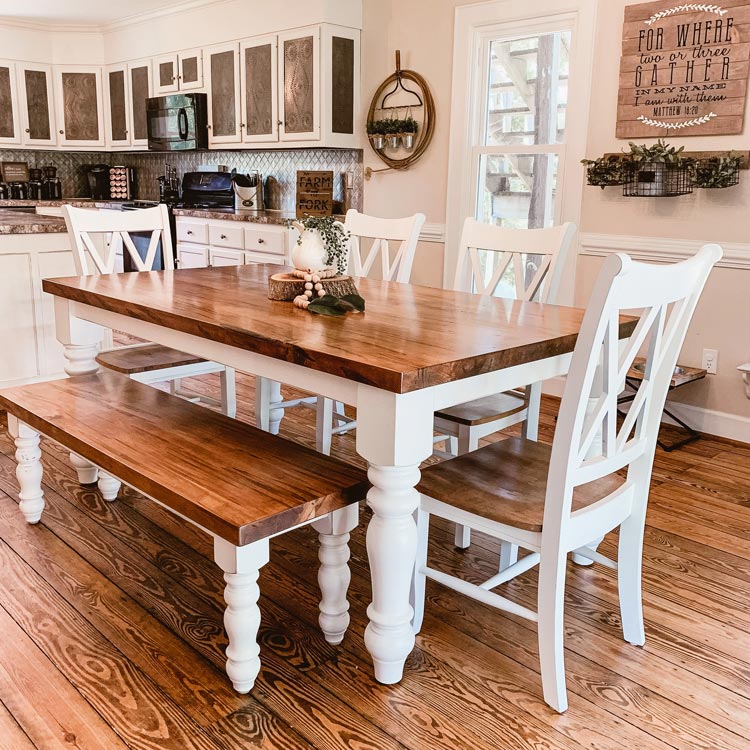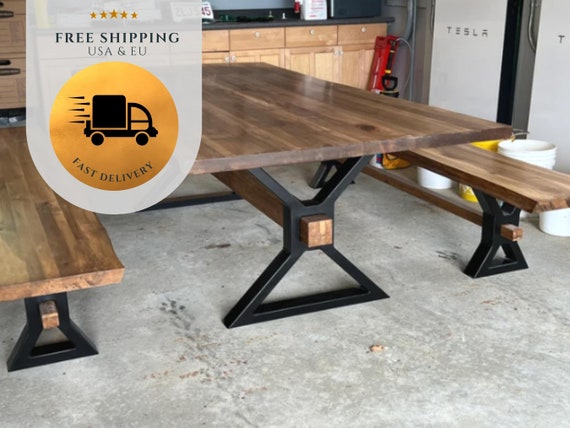Enhance Your Dining Room with Unique and Modern Dining Room Table Legs
Just How to Choose the Perfect Eating Area Table Legs for Your Home Design
Choosing the optimal dining room table legs is a nuanced process that requires cautious consideration of different components, including your area constraints, visual choices, and sensible requirements. The interplay between measurements, materials, and designs can significantly influence the ambiance of your eating location, making it necessary to approach this choice carefully.
Assess Your Dining Room
Analyzing your eating room is crucial for choosing the right table legs that match both aesthetic appeals and capability. Begin by measuring the measurements of your eating location, consisting of ceiling height, flooring area, and closeness to various other furnishings. This information will help establish the ideal size and elevation of your table, which directly influences the selection of table legs.
Following, take into consideration the design and format of your dining room. For example, an open-concept style might benefit from table legs that supply aesthetic lightness, such as slim metal or acrylic alternatives. Conversely, an extra typical setup might ask for durable wooden legs that give a sense of durability.
Review the existing color scheme and materials in your eating area. Balancing the table legs with these elements creates a cohesive appearance that enhances the general style. Furthermore, think concerning the functionality needed in your space. If you often hold big celebrations, think about legs that give additional assistance and stability.
Inevitably, a detailed analysis of your dining area will lead you in making an informed choice, making certain that your table legs not only boost the aesthetic allure but also offer functional objectives.
Consider Your Style Preferences
When picking dining room table legs, it is important to assess your personal design choices, as they significantly affect the total aesthetic of your dining room. Your selection of table legs can either enhance or comparison with existing decor, making it important to align them with your preferred interior decoration motif.
If your home leans in the direction of a contemporary visual, think about streamlined steel or minimal wood legs that give a tidy, minimalist look. For a much more standard strategy, ornate wood legs with intricate makings can add a touch of style and sophistication. Industrial styles benefit from durable, basic materials such as recovered wood and steel combinations, showing a tough appeal.
In addition, farmhouse and rustic designs typically favor durable, chunky legs that evoke a sense of warmth and convenience. Alternatively, if your design is eclectic, you could choose unconventional forms or a mix of products to create aesthetic rate of interest.

Evaluate Material Options
The selection of product for eating area table legs plays a critical duty in both longevity and visual allure. Typical materials include wood, metal, and composite options, each offering unique characteristics that can affect the overall look and durability of your table.
Wood is a traditional selection, known for its heat and convenience. Woods like oak and walnut give outstanding toughness and can be ended up in various spots to match any type of style. Nonetheless, softwoods like pine are extra prone to dents and scratches, making them much less excellent for high-traffic areas.
Steel legs, often crafted from steel or light weight aluminum, radiate modernity and industrial appeal. They are resistant and highly resilient to use, making them suitable for family members with youngsters or frequent celebrations (dining room table legs). In addition, steel can be finished in different colors, improving the personalization possibilities
Composite products, such as MDF or laminate, offer price and varied layouts. While commonly less long lasting than strong timber or steel, they can still provide a trendy appearance and are commonly easy to maintain.
Inevitably, the material you select ought to straighten with your way of living, visual choices, and the level of usage your dining table will experience.
Determine Height and Size
Picking the ideal elevation and dimension for your dining space table is important for both functionality and comfort. The standard elevation for eating tables commonly varies from 28 to 30 inches, allowing enough legroom for many people when seated. It is important to take into consideration the dimensions of your eating room and the kinds of chairs you plan to use.

Additionally, think about the percentages of your dining-room. A bigger table in a sizable location can produce a grand atmosphere, while a smaller table works well in more intimate settings. Eventually, the right height and dimension will certainly balance with your total design and enhance the dining experience for you and your visitors.
Explore Customization Possibilities

Additionally, the layout of the legs can be personalized to fit various designs, such as rustic, modern-day, or commercial. Tapered legs can stimulate a mid-century contemporary feel, while beefy, block-style legs may resonate with standard or farmhouse decor.
Home owners can likewise explore color surfaces, from natural wood spots to paint, enabling them to match or comparison with the tabletop and bordering decoration.
Furthermore, click to read leg elevation can be readjusted to suit particular seating setups or personal preferences, enhancing both comfort and capability.
Last but not least, unique embellishments, such as makings or attractive brackets, can additionally customize the table legs, making the dining experience not just a declaration however a dish item in the home. By taking into consideration these personalization options, property owners can develop a dining-room table that absolutely reflects their originality.
Final Thought
Selecting the perfect dining area table legs requires mindful consideration of various elements, consisting of the dimensions of the dining space, style preferences, material resilience, and desired elevation. Customization options additionally boost the capacity to attain a natural aesthetic that complements the overall decoration. By systematically assessing these elements, house owners can ensure that the selected table legs not only satisfy useful demands yet also contribute favorably to the eating experience and ambiance of the home.
Choosing the ideal eating area table legs is a nuanced process that needs mindful factor to consider of different elements, including your area constraints, visual choices, and functional requirements.Analyzing your dining area is vital for picking the right table legs that complement both visual appeals and performance.When identifying dimension, determine the area where the table will certainly be positioned to ensure it this contact form fits conveniently, enabling for at least 36 inches of clearance around the table for very easy movement. A bigger table in a large area can create a grand setting, while a smaller table works well in more intimate setups.Choosing the suitable dining space table legs requires careful consideration of numerous factors, including the measurements of the dining space, design preferences, product longevity, and desired elevation.